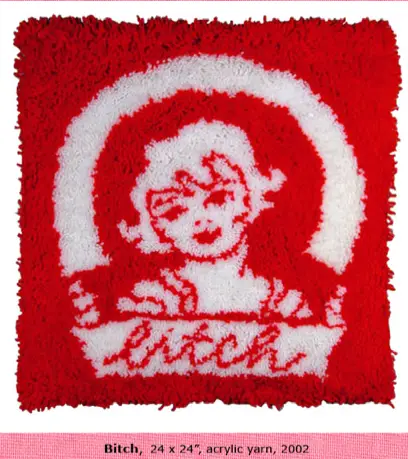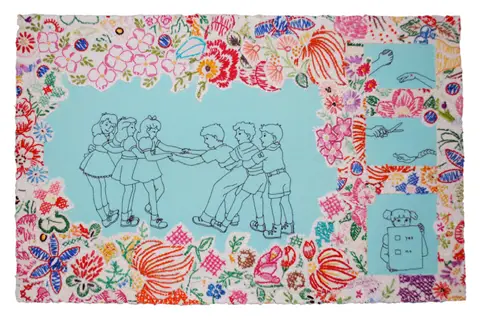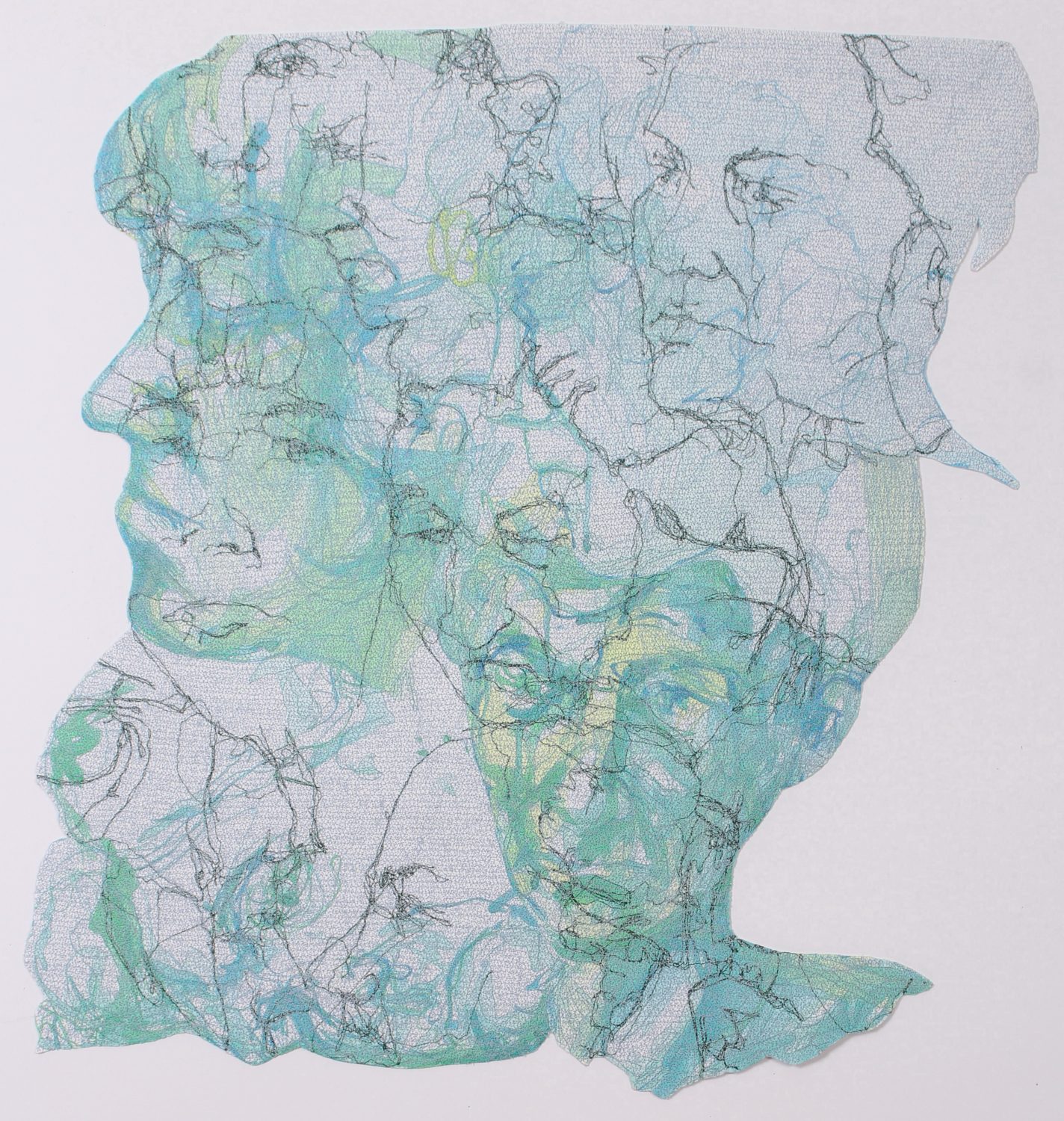
Welcome to Future Heirlooms, where we interview textile artists and explore creativity and technique.
I do not remember when I first came across the work of today’s artist Maggy Rozycki Hiltner but I do know that I immediately enjoyed it. She uses nostalgic figures and imagery to make some playful but poignant remarks about childhood, gender, expectations, friendships, sex, and love.
Her technique is a unique blend of collage with found materials, hand embroidery, machine stitch, and applique. Her humor is clever and at times biting. Her work is fabulous.


Where do you live and how does this affect your work?
I live in Red Lodge, Montana. It’s a cute small town, but pretty limited culturally. Every few months I head to a big city to visit friends and family and soak up some art, good food and new diverse faces. I guess my town provides few distractions. My two small children take care of that!
My previous home, in Wichita, Kansas, really has had a lasting effect on my work. I began working with bright colors and kitsch there, and even some of my lasting themes (truth behind friendly facades, dangerous cuteness!) started there because of the discarded embroidery that I found there in abundance (and the Mid-Western personalities I encountered).

Are you self taught or formally trained?
My mother taught me to sew at a young age. Both my parents are really dexterous and creative-they taught me lots of different skills and instilled in me a confidence that I could figure out how to make just about anything.
I have an undergraduate degree in Sculpture from Syracuse University, but spent a lot of time in the Fibers Department there, weaving and felting and dyeing, etc. I don’t think I committed to embroidery until I was away from school trying to make things on my own. The portability and simple tools were appealing.
I tried to be a quilter for a while, but the process of making the quilt top/batting/backing sandwich didn’t appeal to me–so I just kept making tops and I guess that evolved into what I do now. I’m glad I have a bit of an academic foundation, but just working, working, working for the last decade or so has been the best teacher for me.

How does the practice of embroidery affect the conceptual aspect of your work?
I love to create images that at first appear whimsical or vibrantly happy but on closer inspection are not quite so. Sometimes it’s a malicious undertone to the relationships, or a lack of self-control on the part of the characters, or maybe an otherworldliness hidden in the everyday. I like how this subtext works against the comfortable and innocuous medium of fabric and stitching.


You often use familiar figures such as Dick and Jane characters- Can you talk about this choice and the role of appropriation in your work?
Dick and Jane are characters of my parents’ generation – I love the idealized stereotype they invoke – I just want to poke at them and turn them around for examination. I’m always looking for the truth behind a scene-those saccharine children’s books are just asking to be exposed!
I like setting a pleasant scene, a universal scene with them, maybe reeling in a viewer to a comfortable place and then telling a kind of icky story. Icky is interesting. I have lots of source material to start building my figures from (I also clip figures from the paper or magazines and occasionally my daughters will model for me). Then I cut and paste and redraw and redress the figures until they are doing just what I need them to do.

To me your work seems very personal- Does autobiography play a role in your work?
Just about all my work is autobiographical! Like any storyteller I embellish for effect. I definitely spend a lot of time in my head, in memories, while stitching. I think that is the nature of embroidery: hands busy, mind wandering.
‘Is it autobiography if parts of it are not true? Is it fiction if parts of it are?‘ Lynda Barry

Can you talk about the role of memory in your work?
I’m fascinated by how memory works. Why do some scenes and stories stick and others are only vaguely available to me? Why are some of my most recurring memories so emotionally charged while others are thoroughly mundane. I’ve found that in recreating these moments in my work, they change in how I hold them in my mind.
My hope is that if the image I’ve created feels true, it will transmute for the viewer, evoke a recognition in them. Our anxieties, insecurities, joys and pains are oddly common.

Your work is very narrative, can you talk about the role of narrative and the “page” in your work?
I often create one “page” vignettes that give a glimpse of a story. These seem to be helped along with a bit of information in the title. I also make long scroll-like (Bayeux Tapestry inspired) multiple scene pieces that get to follow their characters on a longer journey.

You often layout your work in a way that references comic books, do comics influence you?
I recently did a series of works very much influenced by comics – in fact I printed comic books from images of the original work. I love comic sexuality and violence – all turned up and ridiculous and cathartic.
I wanted to tell some racier stories, and Dick and Jane seemed just too plain titillating in those roles, so I made animal avatars for them. Unicorns and grumpy bears getting it on – nice!
Lynda Barry, Megan Kelso, Renee French, Esther Pearl Watson and Robert Crumb are some of my favorite comic artists. I look to comics to see how to fit lots of information in a small visual space, how to visually move a story along. I also love Persian miniatures, Tibetan mandalas and Chinese ad art-such great use of space.

How has your work evolved since you first began working with embroidery?
Since beginning this type of work in 1999 or so, I’ve gotten better at drawing figures, not having to rely as heavily on my source material. I’ve experimented with other media-scouring pads, latchhook, even the comic book stuff was fun to try. I want to keep challenging myself and playing.
My line is usually the fine black tidy line, but I sew the messier colorful stuff a lot more now and work it in with the found colorful embroidery – kind of counterfeiting found embroidery. I like toying with that line of who made what in the pieces. (It really is amazing the weird stitched images I do find.)
My work is almost all hand-stitched now-I zig-zag the edges of the Mad Moms and occasionally use a machine to make very long straight lines. People often ask if my figures are machined, but, no, its just a small backstitch. I’m lousy with a sewing machine-I break them too often jamming cloth in and yanking too much.

Describe your studio and studio practice.
I’ve been lucky to always have had some space to work-an extra bedroom or basement or laundry room on top of the dryer, but my current studio is the first one that I got to design to fit me and my work.
I often work standing up, so I have a tall 4 x 8′ table with a white top. Lots of drawers and bins. Space between the rafters for flat work. Copy machine and light boxes. I’m still in need of a comfy chair in there-my husband got me a sexy red leather one, but I slide down in it all the time!.

I try to have a babysitter or have my girls hang out with their dad about 20 hours a week so I can be in my studio.
My thinking and drawing work is done when I can be alone, and my stitching work is done any spare moment I have. I get up early and stay up late. If my husband is driving, I stitch in the car. I’ve got a small hoop in a zip lock bag in my purse. I have multiple hoops going all the time. I can stitch with the tv on, but it slows me down. I feel most “normal” when I’m sewing.

Can you describe the process of making a piece from beginning to end? How do you decide what to embroider and what to collage/applique?
Right now I’m working on another large piece, this one inspired by maps. Well-dressed children definitely show up, as well as a profusion of flora and ill-behaved fauna.
I’ve been collecting images of potential characters for months in a file, as well as bits of found embroidery that I plan to include. I stitched out dozens of small colorful images that will be part of the piece as well.
After all the components are stitched or gathered, I back them with fusible adhesive and start building the piece. Once things are in place (and any additional images are made and added) I fuse everything down and start stitching it down as well.
This is really how all my work is done, no matter the size. I start with an idea (usually a few words jotted on the back of a receipt or something since I always seem to get ideas in the car), gather images and cloth, fabricate what I need to, and then add any decorative elements intuitively.

Tell us more about your life other than your art?
Okay, here is all the wonderful, nerdy stuff that takes me away from stitching: my sweet husband, who is like a siren song to go to bed or lay on the couch or just goof off. My two girls, ages 2 and 7, with all the requisite potty-training, incessant meal preparing and cleaning up, laundry and hair-brushing that seem to come with them (plus lots of Barbie, Pet Shop and art projects).
I’m a volunteer art teacher for K-4 at my daughter’s school and PTA Secretary (never thought I’d aspire to that) as well as very active at that school. We have chickens and a garden. I love to cook and bake, and we entertain a lot.
If I have a hobby, I guess it is seasonal decorating – I’m gearing up to get out the boxes and boxes of Christmas stuff. I live in Montana, but I’m kind of not-so-outdoorsy, fear of large predators I guess.

A day in the life of you.
So here is a day: get up by 6:30, go out and open the chicken coop (did I mention it snows October-June here? Ugh. So I might have to shovel the chicken run), make coffee, wake, dress and feed 2nd grader, feed, wipe and distract 2-year old until her sister leaves for school with her dad at 7:30, do household chores and play until 10, feed kid again, do chores and play until noon, feed kid and put her down for nap, (this involves reading, singing and pretending to sleep as well), shower (optional) and stitch until 2, wake up little one and plop her in the car, go pick up 2nd grader (one hour round-trip to the rural school), grocery shop if needed, come home and do chores and play with the two of them until 5, (hopefully Dad is home by now), go out and close chicken coop (eggs!), prepare dinner, eat at 6, then baths or a fabulous episode of Funniest Home Videos (the kids favorite show), reading then bedtime at 7:30 (drama optional), clean up kitchen and then hang with my sweetie (hopefully while stitching) until 10 or so, bed. Please insert email, phone, dog chores, etc. If I have a babysitter, she comes from 8-2, so I get to go out to studio after breakfast and come in after nap-whew! If I have a deadline or drink a bunch of coffee, I stay up later to sew.

Where can we see your work?
My website is www.maggyrhiltner.com. You can also follow my Instagram. There are lots of links there, as well as what shows are coming up. I’m in the MOM show at Turman Larison Contemporary right now…and here is the link to my upcoming shows.

Maggy at work.
If you like Maggi’s work, we have another post about her here!



